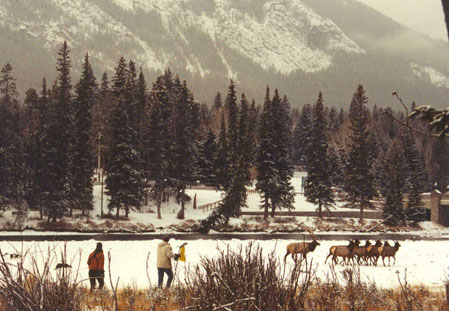Elk management
Banff National Park
Elk are large magnificent animals and a vital part of Banff National Park's ecosystem. As the main herbivore in the park, elk are a major food source for carnivores such as wolves.
High elk concentrations in the Banff townsite over the last 15 years have resulted in serious ecological impacts, such as vegetation degradation and upsets in predator/prey relationships, and growing public safety concerns.
Elk Management Strategy
In 1992, a community-based Elk Advisory Committee was formed to consult with Parks Canada regarding elk management actions to reduce human-elk conflicts. In the first five years, the Committee focussed on education programs, areas for preventative closures and guiding some research projects. In 1999, Parks Canada and a re-vitalized Elk Advisory Committee implemented the Banff National Park Elk Management Strategy. This strategy took an adaptive management approach and had two key goals: the restoration of natural ecological processes on lands adjacent to the town; and the reduction of elk-human conflicts.
Objectives:
-
Restore wildilfe corridors; re-connect predators and prey
-
Reduce elk-human and wildlife-human conflict.
-
Reduce elk population (Central Zone of Bow Valley)
-
Increase elk wariness and migratory behaviour
-
Restore willow/ aspen indicator communities
-
Reduce artificial elk attractants
Reducing the Herd

Elk handling facility
As part of the Strategy, a total of 212 habituated “townsite” elk were trapped and re-located out of the Bow Valley between 1999 and 2002. Once these animals were removed, an aversive conditioning program was implemented on the remainder of the herd to increase the wariness of elk toward humans, restore their migratory behaviour, and teach them to avoid the townsite.
Preliminary results:
- Corridor restoration has improved predator access to prey.
- Public safety target achieved. Reports of aggressive elk incidents down from 106 (1999) to 19 (2003); 1 contact charge (2003) after an average of 7 per year (1995 - 99).
- Elk population target met (1 year early).
- Increased proportion of migrant elk.
- Elk wariness levels have increased with aversive conditioning trials.
- Less than a dozen highly habituated elk continue to frequent the townsite regularly, but these may lead others to follow.
- Willow vegetation indicators have responded to reduced herbivory (browsing). Aspen communities have been slower to respond.
- Strong limiting effects of wolves on elk appears essential to maintain integrity of the park ecosystem.
Research & Monitoring
Research and monitoring are key tools in the Elk Management Strategy. Research projects over the past five years include:
-
Aspen, Elk and Fire in the Canadian Rockies: C. White, University of British Columbia/ Parks Canada
-
Herbivory Interactions Between Elk, Beavers and Willows: C. Nietvelt, University of Alberta
-
Banff Wildlife Corridors: D. Duke, University of Alberta
-
Cougar-Wolf-Urban Interactions: A. Kortello, University of Idaho
-
Aversive Conditioning of Elk: E. Kloppers, University of Alberta
-
Movement Patterns of Elk in Response to Predation Risk and Forage Quality: John McKenzie, University of Guelph

Aversive conditioning trials with dogmaster, John Zehnder
© Elsabe Kloppers
Plus…
-
Ongoing Wildlife Corridor Monitoring: Parks Canada
-
Biannual elk population surveys: Parks Canada
The Elk Advisory Committee
The Elk Advisory Committee is an important component of the Elk Management Strategy. Project updates and new initiatives for the Strategy are reviewed and discussed twice a year with a group of park staff and interested stakeholders, including representatives from the Town of Banff, Banff Centre, Banff Springs Hotel & Golf Course, Town of Canmore, Banff - Lake Louise Hotel/ Motel Association, Banff - Lake Louise Tourism Bureau, Bow Valley Naturalists, Central Rockies Wolf Project and the public.
Future Challenges: Low Prey, Declining Predators, and Ecosystem Resilience
- Continue ecological research.
- Maintain aversive conditioning program.
- Reduce human-caused wildlife mortality and habituation.
- Restore productive habitat (e.g. fire).
- Coordinate efforts with neighbours/agencies.
- Maintain predator access to prey via corridors, wildlife crossing structures, regional links and secure habitat.
- Remove 6 – 12 extremely habituated elk that aversive conditioning is not having an effect on; monitor herd response.
- Continue community education and awareness programs to reduce artificial attractants and reduce human-elk conflicts..
- Date modified :